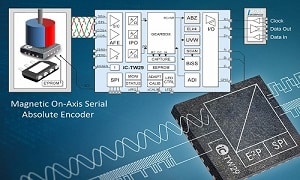- Built in combination with an XMR sensor and a Hall sensor
- Signal processing done using iC-TW29
 iC-Haus introduces a new evaluation board, PVL3M that provides an XMR sensor (AMR angle sensor AA746C from Sensitec) in combination with the multiturn Hall sensor iC-PVL for on-axis absolute angle measurement and revolution counting.
iC-Haus introduces a new evaluation board, PVL3M that provides an XMR sensor (AMR angle sensor AA746C from Sensitec) in combination with the multiturn Hall sensor iC-PVL for on-axis absolute angle measurement and revolution counting.
The two sensors are evaluated with the help of the new 26-bit encoder signal processor iC-TW29 with an integrated EEPROM. The sine/cosine signals from the XMR sensor are processed in the chip, interpolated and result in an output that has an arbitrarily selectable single-turn resolution.
Signal processing via iC-TW29
The iC-PVL provides battery-backed multiturn position to the iC-TW29 via its Absolute Data Interface (ADI). This combination can be used to make a magnetic multiturn serial absolute encoder. For instance, a BiSS encoder with an angular resolution of 17 bits and 24 revolution counting bits is possible. Signal processing time is only 5 µs, which is very close to that of optical encoders. Simultaneously, Auto Calibration in the iC-TW29 corrects the sine/cosine signal errors ensuring high measurement accuracy over temperature or with an axial play of the motor shaft.
Position output via SPI or incremental quadrature signals with an index at any arbitrary resolution (FlexCount) from 1 to 32,768 CPR is also possible.
Requiring a single-sided supply of +3.3 V, the sensors, as well as the iC-TW29, operate over an industrial operating temperature range of –40 degrees Celsius to +125 degrees Celsius.
As for external circuitry, only a few components are required; typically just a voltage regulator and a transceiver for data communication (BiSS/SSI) are needed.
The iC-TW29 is housed in a space-saving 32-pin QFN package which requires only 5 mm x 5 mm on the PCB. For sampling purposes, ready-to-use demo boards (which can also serve as programming adapters) and a PC operating program (GUI) are available.






